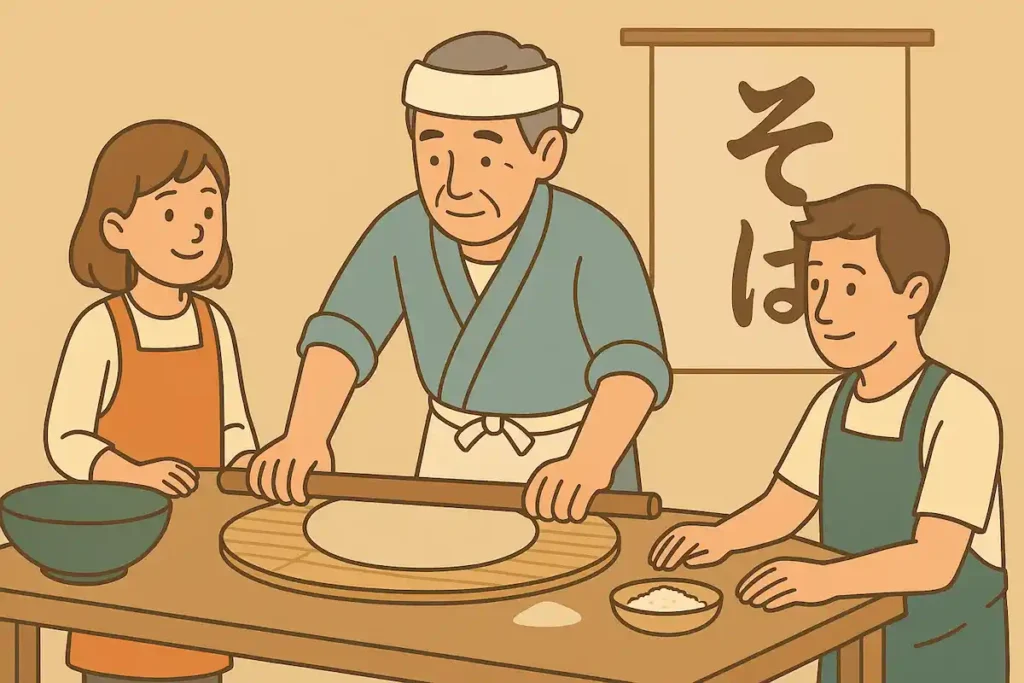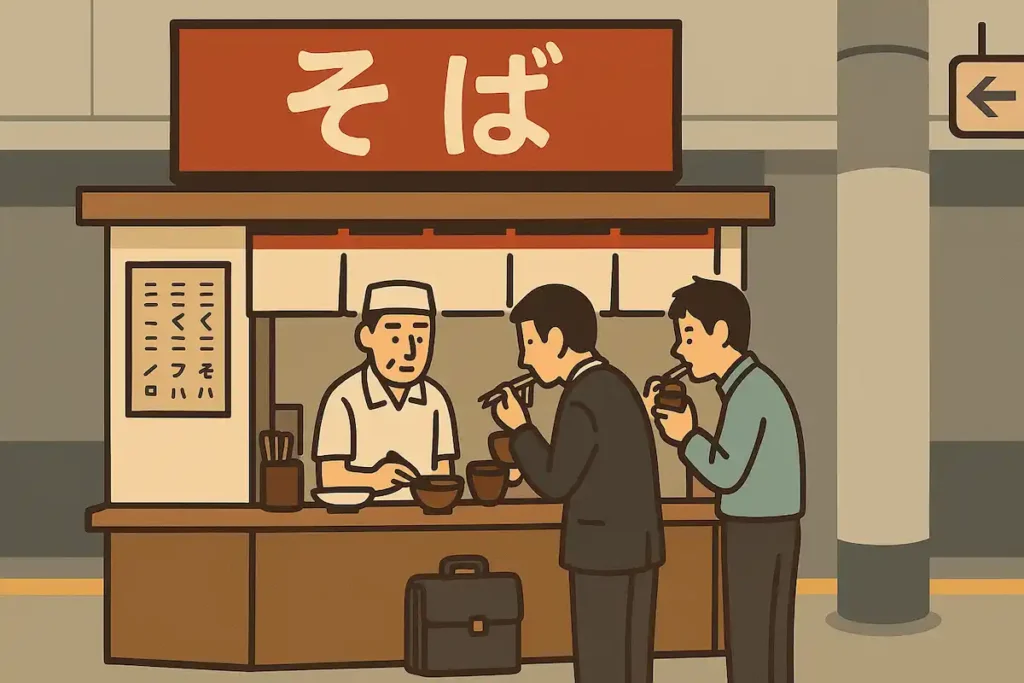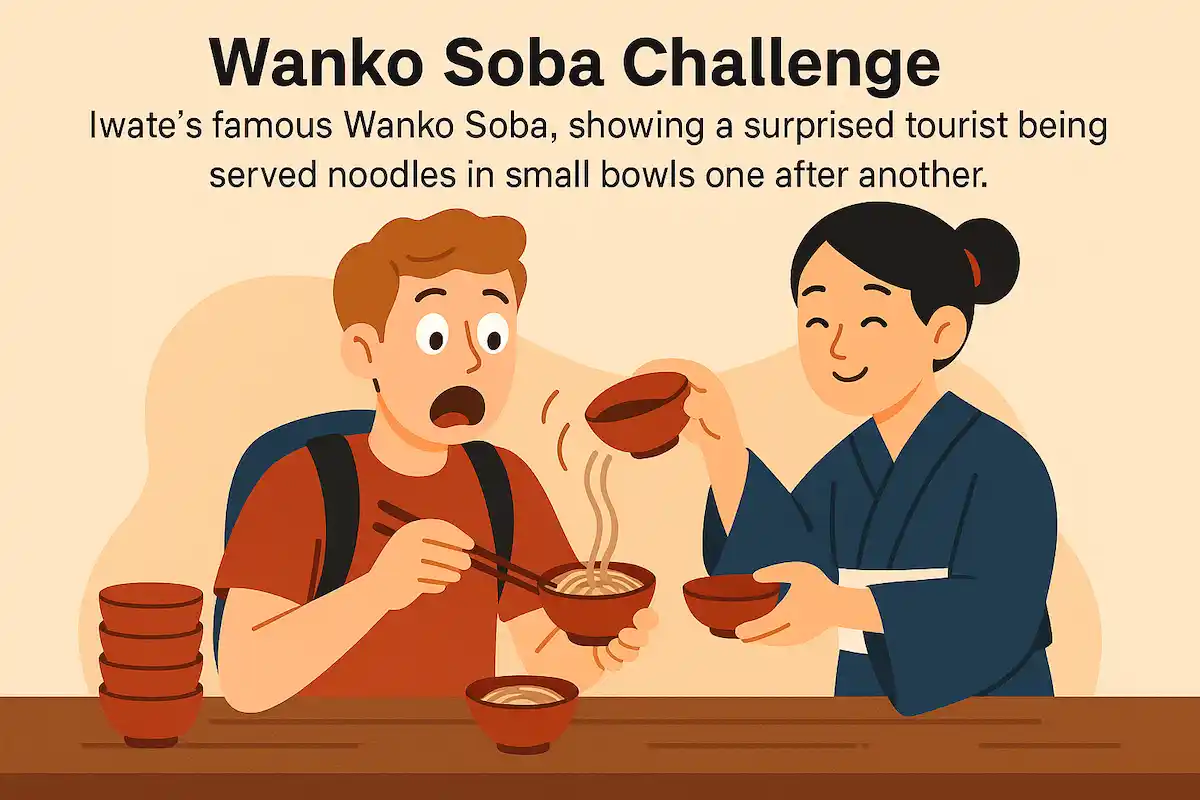蕎麦を英語で説明・紹介するための基本情報と、英会話に役立つ表現をシンプルでわかりやすい英語で紹介します。
英会話ダイアローグ・概要・10の質問を通して、蕎麦に関する英語表現を学びます。
英語
英会話ダイアローグを読む前に知っておくと良い前提知識と情報です。
- 蕎麦の基本
- そば粉から作る日本の伝統的な麺料理
- 江戸時代に手軽に食べられる「ファストフード」として人気を博した
- 冷たくも温かくも食べられ、一年を通して人気
- 主な食べ方と種類
- ざるそば/もりそば:冷たくして、つゆに付けて食べる
- かけそば:温かい出汁に入ったそば
- 天ぷらそば、とろろそば、山菜そばなどトッピングも豊富
- 食後に「そば湯」(茹で汁)をつゆに入れて飲むのも特徴的
- 文化的な意味
- 年越しそば:大晦日に食べる習慣、長寿や厄除けを願う
- 立ち食いそば:駅などで素早く食べられる庶民的なファストフード
- 蕎麦の魅力
- 健康的:たんぱく質や食物繊維、ルチンなどの栄養素が豊富
- 四季を感じられる:冷たいそばは夏、温かいそばは冬など、季節ごとに楽しめる
- シンプルだけど奥深い:素材や打ち方で味が変わる
- 地域の特色
- 信州そば(長野県):有名な蕎麦の産地
- 出雲そば(島根県):濃い色で風味が強い
- わんこそば(岩手県):小さな椀で何杯も食べる名物料理
2人が蕎麦について話しています。
蕎麦の歴史や種類、立ち食いそば、季節感や地域ごとの特徴、年越しそばやそば湯などを話題にしています。
会話 / dialogue

Hey Key, you know what? I’ve really started to like soba recently.

Oh, that’s great! Soba is one of Japan’s classic foods. What do you like about it?

I love how light it feels compared to udon or ramen. And it tastes kind of nutty.

Exactly. That’s because soba is made from buckwheat flour, not just wheat.

How long has soba been part of Japanese food culture?

More than a thousand years. It became especially popular during the Edo period, when people in Tokyo wanted quick and healthy meals.

Oh, so it was like fast food back then?

Yes, and that tradition continues with tachigui soba, those stand-and-eat soba shops you see at train stations.

I’ve tried one near Shinjuku Station. It was super cheap and fast.

Right, but soba isn’t only for quick meals. There are also high-end restaurants that serve handmade soba with very fine quality.

Interesting. Are there different types of soba dishes?

Many! Zaru soba is served cold with dipping sauce, kake soba is hot in broth, and tempura soba is very popular too.

I think I’ve had zaru soba in summer. It was really refreshing.

Yes, soba reflects the seasons. Cold soba in summer, hot soba in winter, and toppings change with seasonal ingredients.

That makes it more than just noodles—it’s cultural.

Exactly. On New Year’s Eve, people eat toshikoshi soba. The long noodles symbolize long life and good luck.

Wow, I didn’t know soba had that meaning.

And there’s also soba-yu. After eating cold soba, you pour the hot water from boiling soba into the sauce and drink it like soup.

I’ve seen that, but I wasn’t sure why people did it.

It’s healthy, because the nutrients from buckwheat remain in the water.

Are there regional soba styles too?

Yes. Shinshu soba from Nagano is famous, Izumo soba in Shimane is darker and stronger, and Wanko soba in Iwate is served in many small bowls.

Oh, Wanko soba! That’s the one where they keep refilling your bowl, right?

Exactly. It’s more like a fun challenge than a normal meal.

No wonder soba is so popular. It’s healthy, seasonal, cultural, and fun.

That’s the appeal of soba. It’s simple but deep, and it connects daily life with tradition.
概要(蕎麦の種類・歴史・人気の理由)
「蕎麦」について、理解を深めるための「英語での概要」です。
蕎麦

What is Soba?
Soba is a traditional Japanese noodle made from buckwheat flour. It is thinner than udon and lighter than ramen. The taste is a little nutty, and many people find it refreshing. Soba can be eaten both hot and cold, which makes it enjoyable in every season.
History and Culture
Soba has been part of Japanese food culture for more than one thousand years. It became especially popular during the Edo period, when busy people in Tokyo needed quick and healthy meals. Even today, soba keeps this role. On New Year’s Eve, Japanese people eat toshikoshi soba. The long noodles are a symbol of long life and good fortune.
Different Ways to Eat
There are many types of soba dishes. Zaru soba is served cold with dipping sauce, perfect for summer. Kake soba is served hot in broth, good for winter. Other famous styles are tempura soba with fried shrimp, and tororo soba with grated yam. After finishing cold soba, people often drink soba-yu, the hot water from boiling noodles, mixed with sauce.
Regional Varieties
Each region in Japan has its own special soba. Nagano is famous for Shinshu soba, Shimane for Izumo soba, and Iwate for Wanko soba, where many small bowls are served one after another. These regional styles show Japan’s rich food culture.
Why Soba is Special
Soba is healthy because buckwheat has protein, fiber, and minerals. It is also simple but deep, with many variations. From quick tachigui soba shops at stations to fine handmade soba restaurants, soba is loved by people of all ages.
10の質問(蕎麦を知るための基本知識)
「蕎麦」について、理解を深めるための「英語での10の質問」です。
1: What is soba?
Soba is a traditional Japanese noodle made from buckwheat flour. It is thinner than udon and has a light, nutty taste.
2: How long has soba been eaten in Japan?
Soba has been eaten in Japan for more than one thousand years. It became very popular during the Edo period.
3: What are the main types of soba dishes?
The main types are zaru soba (cold with dipping sauce), kake soba (hot in broth), tempura soba, and tororo soba with grated yam.
4: Why do people eat soba on New Year’s Eve?
People eat toshikoshi soba because the long noodles are a symbol of long life and good fortune.
5: What is soba-yu?
Soba-yu is the hot water used to boil soba noodles. After eating, people mix it with dipping sauce and drink it like soup.
6: Are there regional varieties of soba?
Yes. For example, Shinshu soba from Nagano, Izumo soba from Shimane, and Wanko soba from Iwate are all famous.
7: What makes soba healthy?
Soba is healthy because buckwheat has protein, fiber, and minerals. It is also easy to digest.
8: Where can people eat soba in Japan?
People can eat soba in many places, from simple tachigui soba shops at train stations to fine handmade soba restaurants.
9: Why is soba popular with tourists?
Soba is popular because it is tasty, healthy, and connected to Japanese culture. Tourists also enjoy soba-making workshops.
10: What is special about Wanko soba?
Wanko soba is served in many small bowls. The staff keeps refilling your bowl until you say stop, so it is like a fun food challenge.

和訳付
会話 / dialogue

Hey Key, you know what? I’ve really started to like soba recently.
ねえキー、聞いてよ。最近、蕎麦が本当に好きになってきたんだ。

Oh, that’s great! Soba is one of Japan’s classic foods. What do you like about it?
いいね!蕎麦は日本の代表的な食べ物の一つだよ。どんなところが気に入ったの?

I love how light it feels compared to udon or ramen. And it tastes kind of nutty.
うどんやラーメンより軽い感じがするのが好きなんだ。それに少しナッツっぽい風味がするよね。

Exactly. That’s because soba is made from buckwheat flour, not just wheat.
そうそう。あれは小麦じゃなくて、そば粉から作られているからなんだよ。

How long has soba been part of Japanese food culture?
蕎麦って、日本の食文化にどれくらい前からあるの?

More than a thousand years. It became especially popular during the Edo period, when people in Tokyo wanted quick and healthy meals.
1000年以上前からだよ。特に江戸時代には、江戸の人たちが手早くて健康的な食事を求めていて、すごく人気になったんだ。

Oh, so it was like fast food back then?
へえ、じゃあ当時のファストフードみたいなものだったんだね?

Yes, and that tradition continues with tachigui soba, those stand-and-eat soba shops you see at train stations.
そうだよ。その伝統は今も続いていて、駅で見かける立ち食いそば屋がその名残なんだ。

I’ve tried one near Shinjuku Station. It was super cheap and fast.
新宿駅の近くで食べたことあるよ。すごく安くて早かったなあ。

Right, but soba isn’t only for quick meals. There are also high-end restaurants that serve handmade soba with very fine quality.
そうだね。でも蕎麦は早いだけじゃないんだ。高級店では、職人が手打ちした本格的な蕎麦も味わえるよ。

Interesting. Are there different types of soba dishes?
へえ、面白いな。他にもいろいろな種類の蕎麦料理があるの?

Many! Zaru soba is served cold with dipping sauce, kake soba is hot in broth, and tempura soba is very popular too.
たくさんあるよ!ざるそばは冷たいつゆで食べるし、かけそばは温かい出汁。天ぷらそばも人気だね。

I think I’ve had zaru soba in summer. It was really refreshing.
夏にざるそばを食べたことあるけど、すごくさっぱりしてたよ。

Yes, soba reflects the seasons. Cold soba in summer, hot soba in winter, and toppings change with seasonal ingredients.
そうなんだ。蕎麦は季節を映しているんだよ。夏は冷たいそば、冬は温かいそば、トッピングも旬の食材で変わるんだ。

That makes it more than just noodles—it’s cultural.
そう聞くと、単なる麺料理じゃなくて文化だね。

Exactly. On New Year’s Eve, people eat toshikoshi soba. The long noodles symbolize long life and good luck.
その通り。大晦日には年越しそばを食べるんだ。長い麺は長寿や幸運を象徴しているんだよ。

Wow, I didn’t know soba had that meaning.
わあ、そんな意味があったなんて知らなかったよ。

And there’s also soba-yu. After eating cold soba, you pour the hot water from boiling soba into the sauce and drink it like soup.
それから「そば湯」もあるんだ。冷たいそばを食べたあとに、茹でたお湯をつゆに入れてスープみたいに飲むんだよ。

I’ve seen that, but I wasn’t sure why people did it.
見たことあるけど、なんでそうするのか分からなかったよ。

It’s healthy, because the nutrients from buckwheat remain in the water.
健康にいいんだ。そば粉の栄養がそのお湯に溶けているからね。

Are there regional soba styles too?
地域ごとにも蕎麦のスタイルってあるの?

Yes. Shinshu soba from Nagano is famous, Izumo soba in Shimane is darker and stronger, and Wanko soba in Iwate is served in many small bowls.
あるよ。長野の信州そばは有名だし、島根の出雲そばは濃くて力強い味。岩手のわんこそばは小さなお椀にどんどん出てくるんだ。

Oh, Wanko soba! That’s the one where they keep refilling your bowl, right?
あ、わんこそば!あれってお椀にどんどん入れてくれるやつだよね?

Exactly. It’s more like a fun challenge than a normal meal.
そうそう。普通の食事というより、楽しい挑戦みたいなものだよ。

No wonder soba is so popular. It’s healthy, seasonal, cultural, and fun.
なるほど、だから蕎麦は人気なんだね。健康的で、季節感もあって、文化的だし、楽しめるし。

That’s the appeal of soba. It’s simple but deep, and it connects daily life with tradition.
それが蕎麦の魅力なんだ。シンプルだけど奥深くて、日常と伝統をつないでいるんだよ。
概要(蕎麦の種類・歴史・人気の理由)
蕎麦

What is Soba?
Soba is a traditional Japanese noodle made from buckwheat flour. It is thinner than udon and lighter than ramen. The taste is a little nutty, and many people find it refreshing. Soba can be eaten both hot and cold, which makes it enjoyable in every season.
蕎麦はそば粉から作られる日本の伝統的な麺料理です。うどんより細く、ラーメンよりも軽い食感が特徴です。少しナッツのような風味があり、さっぱりしていると感じる人も多いです。冷たくも温かくも食べられるため、一年を通して楽しめます。
History and Culture
Soba has been part of Japanese food culture for more than one thousand years. It became especially popular during the Edo period, when busy people in Tokyo needed quick and healthy meals. Even today, soba keeps this role. On New Year’s Eve, Japanese people eat toshikoshi soba. The long noodles are a symbol of long life and good fortune.
蕎麦は1000年以上にわたり日本の食文化の一部となっています。特に江戸時代には、忙しい江戸の人々が手早く健康的な食事を求め、人気を集めました。現代でもその役割は続いています。大晦日には「年越しそば」を食べ、長い麺に長寿や幸運を願う意味が込められています。
Different Ways to Eat
There are many types of soba dishes. Zaru soba is served cold with dipping sauce, perfect for summer. Kake soba is served hot in broth, good for winter. Other famous styles are tempura soba with fried shrimp, and tororo soba with grated yam. After finishing cold soba, people often drink soba-yu, the hot water from boiling noodles, mixed with sauce.
蕎麦の食べ方には多くの種類があります。ざるそばは冷たいつゆにつけて食べる夏にぴったりのスタイル、かけそばは温かい汁に入った冬に合うスタイルです。他にも、エビの天ぷらを添えた天ぷらそばや、とろろ芋をかけたとろろそばが有名です。冷たいそばを食べた後は、茹で汁である「そば湯」をつゆに入れて飲むのも一般的です。
Regional Varieties
Each region in Japan has its own special soba. Nagano is famous for Shinshu soba, Shimane for Izumo soba, and Iwate for Wanko soba, where many small bowls are served one after another. These regional styles show Japan’s rich food culture.
日本各地には特色ある蕎麦があります。長野の信州そば、島根の出雲そば、岩手のわんこそばなどが有名で、わんこそばは小さなお椀に次々とそばが盛られていきます。こうした地域ごとのスタイルは、日本の食文化の豊かさを物語っています。
Why Soba is Special
Soba is healthy because buckwheat has protein, fiber, and minerals. It is also simple but deep, with many variations. From quick tachigui soba shops at stations to fine handmade soba restaurants, soba is loved by people of all ages.
そば粉にはたんぱく質、食物繊維、ミネラルが含まれているため、蕎麦は健康的な食べ物です。また、シンプルでありながら奥深く、多彩なバリエーションがあります。駅の立ち食いそばから本格的な手打ちそばの高級店まで、蕎麦は幅広い世代に愛されています。
10の質問(蕎麦を知るための基本知識)
1: What is soba?
蕎麦とは何ですか?
Soba is a traditional Japanese noodle made from buckwheat flour. It is thinner than udon and has a light, nutty taste.
蕎麦はそば粉から作られる日本の伝統的な麺料理です。うどんより細く、軽い食感でナッツのような風味があります。
2: How long has soba been eaten in Japan?
蕎麦は日本でどのくらいの期間食べられていますか?
Soba has been eaten in Japan for more than one thousand years. It became very popular during the Edo period.
蕎麦は日本で1000年以上食べられてきました。特に江戸時代にとても人気になりました。
3: What are the main types of soba dishes?
蕎麦の主な種類は何ですか?
The main types are zaru soba (cold with dipping sauce), kake soba (hot in broth), tempura soba, and tororo soba with grated yam.
主な種類は、ざるそば(冷たいつゆで食べる)、かけそば(温かい汁そば)、天ぷらそば、とろろそば(すりおろした山芋をのせる)です。
4: Why do people eat soba on New Year’s Eve?
人々はなぜ大晦日に蕎麦を食べるのですか?
People eat toshikoshi soba because the long noodles are a symbol of long life and good fortune.
大晦日に年越しそばを食べるのは、長い麺が長寿と幸運の象徴だからです。
5: What is soba-yu?
そば湯とは何ですか?
Soba-yu is the hot water used to boil soba noodles. After eating, people mix it with dipping sauce and drink it like soup.
そば湯は蕎麦をゆでたお湯のことです。食後に残ったつゆに加えて、スープのように飲みます。
6: Are there regional varieties of soba?
蕎麦には地域ごとの種類がありますか?
Yes. For example, Shinshu soba from Nagano, Izumo soba from Shimane, and Wanko soba from Iwate are all famous.
はい。例えば、長野の信州そば、島根の出雲そば、岩手のわんこそばなどが有名です。
7: What makes soba healthy?
蕎麦が健康的とされるのはなぜですか?
Soba is healthy because buckwheat has protein, fiber, and minerals. It is also easy to digest.
蕎麦が健康的とされるのは、そば粉にたんぱく質、食物繊維、ミネラルが含まれているからです。また消化にも良いです。
8: Where can people eat soba in Japan?
日本ではどこで蕎麦を食べられますか?
People can eat soba in many places, from simple tachigui soba shops at train stations to fine handmade soba restaurants.
日本では、駅にある立ち食いそばのような手軽なお店から、本格的な手打ちそばの高級店まで、さまざまな場所で食べられます。
9: Why is soba popular with tourists?
なぜ蕎麦は観光客に人気なのですか?
Soba is popular because it is tasty, healthy, and connected to Japanese culture. Tourists also enjoy soba-making workshops.
蕎麦はおいしくて健康的で、日本文化と深く結びついているため、観光客に人気です。また、そば打ち体験も観光客に好まれています。
10: What is special about Wanko soba?
わんこそばの特別な点は何ですか?
Wanko soba is served in many small bowls. The staff keeps refilling your bowl until you say stop, so it is like a fun food challenge.
わんこそばは小さなお椀に何度もそばが盛られます。店の人が「もう結構です」と言うまで入れ続けるので、楽しい食の挑戦のようなものです。

words & phrases
英会話ダイアローグと関連情報に出てきた単語・フレーズです(例文は各3つ)。

classic : 形容詞 /ˈklæs.ɪk/
意味: 古典的な、代表的な。Traditional, typical, or of lasting value.
(蕎麦は日本の「classic food(代表的な料理)」と説明)
例文:
- Soba is a classic Japanese dish.
「蕎麦は日本の代表的な料理です。」 - This movie is a classic example of 1980s cinema.
「この映画は1980年代映画の典型的な例です。」 - Kyoto is famous for its classic temples and gardens.
「京都は古典的な寺や庭園で有名です。」
light : 形容詞 /laɪt/
意味: 軽い、あっさりした。Not heavy in weight, taste, or feeling.
(蕎麦はうどんやラーメンと比べて「light(軽い、あっさりしている)」と表現)
例文:
- Soba has a light taste compared to ramen.
「蕎麦はラーメンと比べてあっさりした味です。」 - This salad is very light but delicious.
「このサラダはとても軽いけれど美味しいです。」 - I prefer a light meal for lunch.
「私は昼食には軽い食事の方が好きです。」
buckwheat flour : 名詞 /ˈbʌk.wiːt ˌflaʊər/
意味: そば粉。Flour made from buckwheat seeds.
(蕎麦は「buckwheat flour(そば粉)」から作られると説明)
例文:
- Soba is made from buckwheat flour.
「蕎麦はそば粉から作られます。」 - This bread uses buckwheat flour instead of wheat flour.
「このパンは小麦粉の代わりにそば粉を使っています。」 - Buckwheat flour is healthy and rich in fiber.
「そば粉は健康的で食物繊維が豊富です。」
wheat : 名詞 /wiːt/
意味: 小麦。A grain used to make flour, bread, and noodles.
(蕎麦は小麦だけでなく「buckwheat」で作られると説明)
例文:
- Udon is made from wheat flour.
「うどんは小麦粉から作られています。」 - Japan imports a lot of wheat from overseas.
「日本は海外から多くの小麦を輸入しています。」 - Some people cannot eat wheat because of allergies.
「小麦アレルギーのために小麦を食べられない人もいます。」
refreshing : 形容詞 /rɪˈfreʃ.ɪŋ/
意味: さっぱりした、爽やかな。Pleasantly fresh, cool, or light.
(夏に食べるざるそばは「refreshing(さっぱりして爽やか)」と説明)
例文:
- Cold soba is very refreshing in summer.
「夏に食べる冷たい蕎麦はとてもさっぱりしています。」 - The drink was sweet and refreshing.
「その飲み物は甘くて爽やかでした。」 - A short walk in the park is refreshing after work.
「仕事の後の公園の散歩は気分がすっきりします。」
詳細情報 / Further Info
関連記事(わんこそば)

